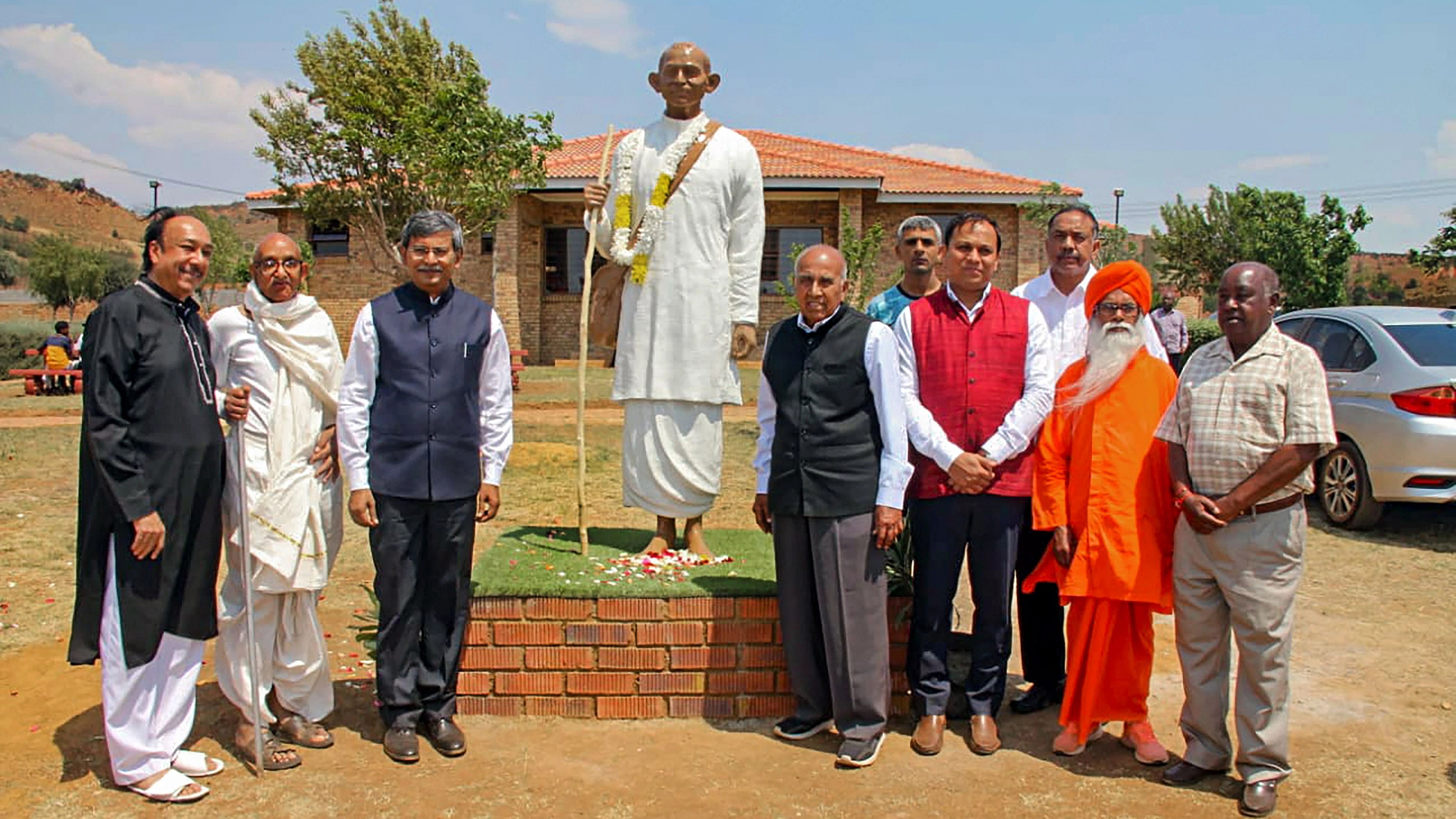
High Commissioner of India to South Africa Prabhat Kumar during unveiling of a life-size statue of Mahatma Gandhi in continuation with Gandhi Jayanti celebrations at the Tolstoy Farm, in South Africa.
Credit: PTI
An eight-foot-tall statue of Mahatma Gandhi has been unveiled at Tolstoy Farm, the commune that he had started during his tenure as a lawyer here in South Africa in the early 20th century.
The larger-than-life clay statue, unveiled on Sunday by the High Commissioner of India, Prabhat Kumar, now joins large busts of Mahatma Gandhi and Nelson Mandela, both commissioned by sculptor Jalandharnath Rajaram Channole, from the Sevagram Ashram in India.
“This statue probably resembles Mahatma Gandhi when he left South Africa at that time. We have seen Mahatma Gandhi’s photographs from 1914, and here he is much older. I think it’s a grand tribute to him at Tolstoy Farm, where he lived for five or six years. From 1910 to 1914, he intermittently lived here,” said Kumar as he unveiled the statue.
Kumar recalled that Gandhi’s friend Herman Kallenbach had donated the farm to establish a self-sufficient commune.
“This was because the people from our community here were struggling against the (discriminatory) pass laws and other laws,” he said, referring to the laws that required non-white citizens to carry passbooks for the indigenous Black African community and Astatic registration papers for Indians. Many men and some women voluntarily went to jail with Gandhi to resist these laws.
“They had to also bring up their families and to sustain those families, Kallenbach bought this farm and donated it to Mahatma Gandhi,” Kumar said as he recounted how these families grew fruits and vegetables on Tolstoy Farm with which they sustained themselves.
The envoy said that the same community spirit had to be re-established at Tolstoy Farm as he commended the Mahatma Gandhi Remembrance Organisation (MGRO) and its head, Mohan Hira, for what they had done to revive Tolstoy Farm.
By the 1990s, Tolstoy Farm had been wholly vandalised and left derelict after the last tenants had moved out.
Surrounded by informal settlements, everything was stripped bare, including the iron and wood house that Gandhi had lived in. Only the foundation, hidden by shoulder-height grass, remained.
Hira, now 84, almost single-handedly started a drive to restore Tolstoy Farm. For his efforts, Hira received the Pravasi Bharatiya Award, India’s highest civilian award for Diaspora Indians, in January this year.
“For the last few years, the MGRO has brought the attention of Tolstoy Farm back to all of us and the High Commission (in Pretoria) and the Consulate General (in Johannesburg) will spare no effort in making Tolstoy Farm self-sufficient in future. This will be our task,” Kumar said.
Kumar also appealed to the local community to get involved in and support this venture as he shared how he had been inspired by reading about and hearing from freedom fighters who had been there what Tolstoy Farm was like.
For this statue, Hira brought out Channole, who first did a cycle tour of Gandhian sites in South Africa before spending three weeks at Hira’s residence in the nearby sprawling Indian township of Lenasia, where the white minority apartheid government forcibly resettled Indians from all over Johannesburg for decades.
“It had always been my dream to have a larger-than-life statue of the Mahatma at Tolstoy Farm from the time I first started cutting down the grass surrounding the remains of his house,” Hira said emotionally as the guests gathered in the library that has been built next to the house with support from the Indian government.
The next phase for Tolstoy Farm is to involve the local communities in running empowerment programmes to make them self-sufficient and alleviate poverty, Hira said.